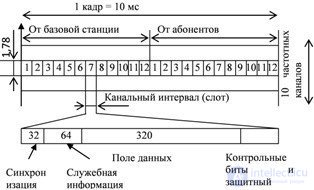Lecture
Cordless telephone systems are designed to provide high quality limited mobile subscribers in an area with a radius of several hundred meters. The principles of building such systems are in many ways similar to the principles of building cellular communication systems, but the maintenance of small territories makes the development of this radio communications sector economically viable.
The first wireless (cordless) telephones were used for personal service in a small area: in the offices of firms, in the residential area, etc. The simplest devices were a handset connected via radio to the rest of the phone (called the base unit or base station). In institutions, the base station served several handsets. To increase the coverage area, several base stations connected to the switch are combined into a radio network. Analog signals were used for communication, frequency division of channels was used in multichannel systems.
With the development of wireless telephone systems, national and international standards began to appear. The cordless telephone system of the first European standard CT1 (Cordless Telephone) serves 40 duplex channels with frequency modulated carrier in the 900 MHz frequency band. Later, the system capacity was doubled, but the main disadvantage of analog systems is the lack of voice encryption.
The next generation of digital-based cordless telephone systems was developed based on the CT2 standard. These devices also use frequency division multiple access, but duplex communication provides time division multiplexing. With time duplex division of channels, the transmission session is divided into time intervals (slots) of a certain duration: during one interval, the signal is transmitted from the base station to the subscriber, during the next interval - from subscriber to the station, etc.
The growing popularity of wireless telephone systems is explained not only by the relative mobility of the subscriber and good signal quality, but also by the ability to transmit various digital information. In Europe, a standard is being developed for DECT (Digital European Cordless Telecommunication) wireless telephone systems, designed to transmit voice messages and data. Both speech and data can be transmitted in encrypted form. DECT systems can be used as a wireless private branch exchange or to provide wireless access for fixed subscriber systems to different networks.
DECT communication systems operate in the 1880 ... 1900 MHz band, divided into 10 frequency channels with a spacing of 1.78 MHz. In each frequency channel, 12 channels with time duplex spacing are organized: during the first half of a frame with a duration of 10 ms, signals are transmitted from the base station to 12 handsets, during the second half of the frame - from 12 moving handsets to the base station (Fig. 10.9

Fig. 10.9 Channel and DECT signal structure
In DECT systems, the choice of channel for communication is assigned to the subscriber device (as opposed to cellular communication systems, where the channel specifies the switching center). Any of the 120 channels can be accessed by any DECT standard device. When establishing a connection, the subscriber unit selects a free channel with good communication quality. Channel quality control continues throughout the communication session, and if the communication channel parameters deteriorate, the subscriber unit switches to a free channel with better characteristics. This type of switching refers to intra-cell. When a subscriber moves to the coverage area of another base station, inter-cell switching is performed.
To protect the communication system from unauthorized access, identification is used of both subscriber devices and the user himself. Before establishing a connection, the communication system checks whether the mobile station has access rights to the DECT: the base station sends an encrypted request to the subscriber device that requires communication. To this request, the mobile station generates an encrypted response, and with the correct answer, the subscriber unit is provided with a communication channel.
To protect the transmitted information from listening, voice and data encryption is provided.
Comments
To leave a comment
Devices for the reception and processing of radio signals, Transmission, reception and processing of signals
Terms: Devices for the reception and processing of radio signals, Transmission, reception and processing of signals